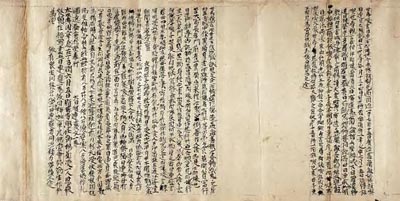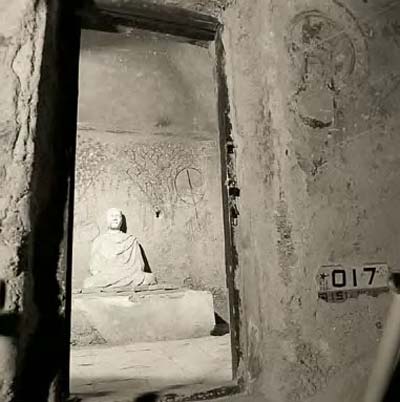Bianwenrefers to a wording style adopted by monasteries and temples to deliver ideas to ordinary people and it employs forms of storytelling and singing to tell sutra stories. From the Wei (220-265) and Jin (265-420) to Sui (581-618) and Tang (618-907) dynasties, Buddhism became widespread in China. Monasteries and temples employed more diverse methods for propaganda, such asZhuandu(reading),Changdao(chanting) andSujiang(discourses).
 |
| Bianwen transcripts discovered in Dunhuang Sutra Hiding Hole |
Sujiangwas very popular in the Tang Dynasty (618-907), when folk artists also began to tell folktales through
Shuochang(storytelling that combines singing and narration) in the form of
Bianwen. At that time,
Shuochangnot only combined singing and narration but also was accompanied by drawings so as to present a clearer picture to the audiences. The wording style of
Bianwenis between prose and verse and is similar to that of Sanskrit sutra, not only inheriting and developing the traditional style but also setting a good example for
Guqu Changci(drumbeat libretto.
After the Northern Song Dynasty (960-1127), various literary forms came into being, includingHuaben(recorded texts of folk storytellers),Cihua(novel with parts in verse),Xiqu(traditional opera) and so on.Bianwen,once popular in the Tang Dynasty, was in decline due to its inconvenient staging and discrimination by feudal rulers. Most of thoseBianwentranscripts we see today were discovered in Dunhuang Sutra Hiding Hole in Gansu Province in 1899.
 |
| The Dunhuang Sutra Hiding Hole |
Storytelling while singing, prevalent after the Tang Dynasty (618-907), was a milestone in the history of Chinese
Quyidevelopment. Several traditional operas that emerged later basically inherited the form. Some contents of prose and songs in
Bianwenwere overlapped and performers at that time did not know to divide the work of them according to functions. Besides, the language was not so vivid, showing the primitiveness of the storytelling art in the initial period.
